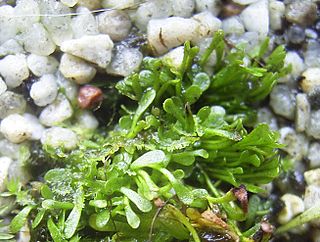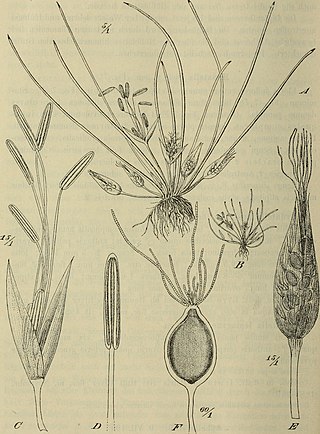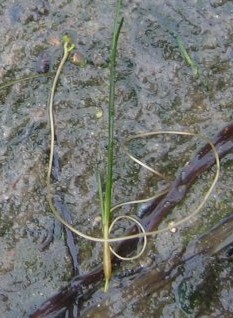
Genlisea is a genus of carnivorous plants also known as corkscrew plants. The 30 or so species grow in wet terrestrial to semi-aquatic environments distributed throughout Africa and Central and South America. The plants use highly modified underground leaves to attract, trap and digest minute microfauna, particularly protozoans. Although suggested a century earlier by Charles Darwin, carnivory in the genus was not proven until 1998.

Vallisneria is a genus of freshwater aquatic plant, commonly called eelgrass, tape grass or vallis. The genus is widely distributed in tropical and subtropical regions of Asia, Africa, Australia, Europe, and North America.

The Potamogetonaceae, commonly referred to as the pondweed family, is an aquatic family of monocotyledonous flowering plants. The roughly 110 known species are divided over six genera. The largest genus in the family by far is Potamogeton, which contains about 100 species.
Antitropicaldistribution is a type of disjunct distribution where a species or clade exists at comparable latitudes across the equator but not in the tropics. For example, a species may be found north of the Tropic of Cancer and south of the Tropic of Capricorn, but not in between. With increasing time since dispersal, the disjunct populations may be the same variety, species, or clade. How the life forms distribute themselves to the opposite hemisphere when they can't normally survive in the middle depends on the species; plants may have their seed spread through wind, animal, or other methods and then germinate upon reaching the appropriate climate, while sea life may be able to travel through the tropical regions in a larval state or by going through deep ocean currents with much colder temperatures than on the surface. For the American amphitropical distribution, dispersal has been generally agreed to be more likely than vicariance from a previous distribution including the tropics in North and South America.

Genlisea aurea is one of the largest carnivorous species in the genus Genlisea. It has pale bundles of root-like organs up to about 15 cm long under ground that attract, trap, and digest protozoans. These organs are subterranean leaves, which lack chlorophyll. G. aurea is endemic to Brazil, where it grows with several other species of Genlisea. It possesses an exceptionally small genome for a flowering plant.

Ruppia, also known as the widgeonweeds, ditch grasses or widgeon grass, is the only extant genus in the family Ruppiaceae, with eight known species. These are aquatic plants widespread over much of the world. The genus name honours Heinrich Bernhard Rupp, a German botanist (1688-1719). They are widespread outside of frigid zones and the tropics.

Hydatellaceae are a family of small, aquatic flowering plants. The family consists of tiny, relatively simple plants occurring in Australasia and India. It was formerly considered to be related to the grasses and sedges, but has been reassigned to the order Nymphaeales as a result of DNA and morphological analyses showing that it represents one of the earliest groups to split off in flowering-plant phylogeny, rather than having a close relationship to monocots, which it bears a superficial resemblance to due to convergent evolution. The family includes only the genus Trithuria, which has at least 13 species, although species diversity in the family has probably been substantially underestimated.
Genlisea margaretae is a carnivorous species in the genus Genlisea native to areas of Madagascar, Tanzania, and Zambia. It has pale bundles of root-like organs up to about 20 cm long under ground that attract, trap, and digest protozoans. These organs are subterranean leaves, which lack chlorophyll. It had been known to possess the smallest known genome of any flowering plant as of 2006, but was later surpassed by the related species Genlisea tuberosa.
Posidonia robertsoniae is one of the seagrasses of Western Australia, submerged flowering plants that occur in the southern coastal waters.

Zannichellia is a genus of submerged aquatic flowering plant, with threadlike leaves and tiny flowers. It is fully adapted to an aquatic life cycle, including underwater pollination.

Callitriche is a genus of largely aquatic plants known as water-starwort. Previously, it was the only genus in the family Callitrichaceae. However, according to the APG II system this family is now included in the Plantaginaceae. The family name Callitrichaceae retains its status as nomen conservandum.

Ruppia cirrhosa is a species of aquatic plant known by the common names spiral ditchgrass and spiral tasselweed. It is native to the Americas and Europe, where it grows in freshwater bodies, such as lakes. It is a thread-thin, grasslike perennial herb which grows from a rhizome anchored in the wet substrate. It produces a long, narrow inflorescence tipped with two tiny flowers. As the fruit develops the peduncle of the inflorescence curls into a neat spiral.

Ruppia maritima is an aquatic plant species commonly known as beaked tasselweed, beaked ditchgrass, ditch grass, tassel pondweed and widgeon grass. Despite its scientific name, it is not a marine plant; is perhaps best described as a salt-tolerant freshwater species. The generic name Ruppia was dedicated by Linnaeus to the German botanist Heinrich Bernhard Ruppius (1689–1719) and the specific name (maritima) translates to "of the sea".
Ruth Mason was a New Zealand botanist specialising in the taxonomy and ecology of freshwater plants. She was employed at the Department of Scientific and Industrial Research for 35 years undertaking research into aquatic plants, pioneering new techniques for plant preservation and collecting over 13,000 plant specimens in the field. She was awarded life membership by the New Zealand Ecological Society.
Ruppia megacarpa is a submerged herb species in the genus Ruppia found in shallow brackish waters. It is a common on Australasian coasts, including Australia (NSW; SA; Vic; WA and New Zealand. Isolated populations have been currently found in East Asia, including Japan, Korea, and Far East Russia, hence, the species distribution exhibit latitudinally disjunct distribution between East Asia and Australasia.

Ruppia polycarpa is a submerged aquatic herb species in the genus Ruppia found in shallow brackish waters. It is a common submerged herb on Australasian coasts, including Australia and New Zealand.
Cryptocoryne cruddasiana is a plant species belonging to the Araceae genus Cryptocoryne.
Norio Tanaka is an aquatic botanist at Tsukuba Botanical Garden, National Science Museum, Tokyo, Japan.
Ruppia bicarpa is an aquatic plant species in the genus Ruppia of Ruppiaceae. It is found in shallow waters.
David Cleland Paton is a conservation ecologist, ornithologist, academic, and author. He is an Adjunct Associate Professor of the School of Biological Sciences at the University of Adelaide and Director of Bio-R, which is an Adelaide-based nonprofit organization. He also co-founded the non-profit organization, Arid Recovery.











